Night Off-Roading in the Mojave Desert: A Different World After Sunset
When the sun drops below the horizon in the Mojave Desert, the landscape changes in surprising ways. The daytime heat fades, stars begin to glow above, and new sounds echo through the silence. For off-road enthusiasts, nightfall doesn’t mean the end of the adventure, it’s the beginning of something entirely different.
Night off-roading in the Mojave Desert isn’t just about exploring in the dark. It’s about seeing the desert in a whole new light, literally. With cooler air, active wildlife, and wide-open night skies, the southern Mojave transforms after sunset. But along with the magic comes a new set of challenges, especially when it comes to visibility, terrain, and safety.
In this guide, we’ll explore what makes night off-roading special, what you need to prepare, and why the southern Mojave Desert is the perfect place to experience it.
Why Try Night Off-Roading?
Most off-road trips happen during the day, but driving into the desert at night offers a unique experience. It’s cooler, quieter, and under the right conditions, it’s more peaceful. But it also demands extra awareness and preparation.
The Desert Feels Bigger at Night
At night, the open spaces of the Mojave feel even more vast. With less visual noise from the sun and heat haze, the terrain opens up in front of your lights like an empty canvas. Shadows stretch across the land. You might feel like you’re the only person for miles, because you probably are.
Fewer People, More Solitude
The southern Mojave Desert is already less crowded than other outdoor destinations near Las Vegas, and it gets even quieter after dark. You won’t run into groups of hikers, tourists, or casual drivers. The trails are yours, which adds a real sense of freedom and adventure.
Nocturnal Wildlife: The Desert Comes Alive
One of the most exciting parts of night off-roading in the Mojave Desert is the chance to see nocturnal animals you’d never spot during the day. As temperatures drop, the desert’s hidden life comes out to move, hunt, and feed.
What You Might See
- Coyotes: Often spotted trotting along back roads.
- Jackrabbits: Quick, alert, and easy to startle into a sprint.
- Owls: Look for them perched on Joshua trees or swooping low over the trail.
- Desert foxes: Small and shy, but sometimes visible around rocky areas.
- Rattlesnakes: Yes, they can be active at night, especially during warmer months—keep your distance.
Wildlife tends to freeze in the lights of your vehicle, giving you a rare moment to observe them. Be respectful. Never chase animals or drive off-trail to get closer.
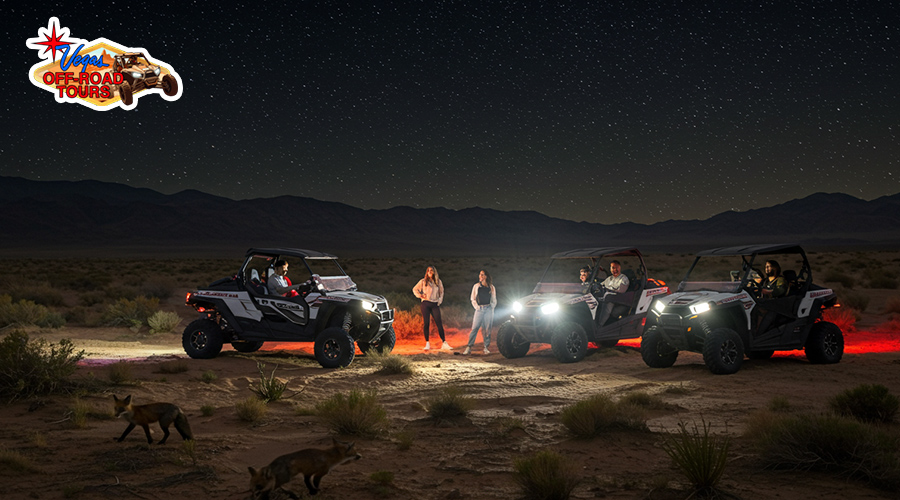
Lighting Setups: What You Really Need
Once the sun sets, your visibility depends entirely on your gear. A proper lighting setup is critical, not just for seeing ahead, but for spotting obstacles and staying safe.
Essential Lights for Night Off-Roading
- LED Light Bars: Mounted on top or front of your vehicle, these provide a wide flood of light.
- Fog Lights: Useful for lighting up close range, especially in dusty or sandy conditions.
- Spotlights: Help with long-distance visibility when you’re on wide-open flats.
- Rock Lights: Mounted near your tires to help you see the ground when crawling over rocks or rough terrain.
Test all your lights before heading out. Carry backup bulbs or a power source, and always have a flashlight or headlamp in case of emergency.
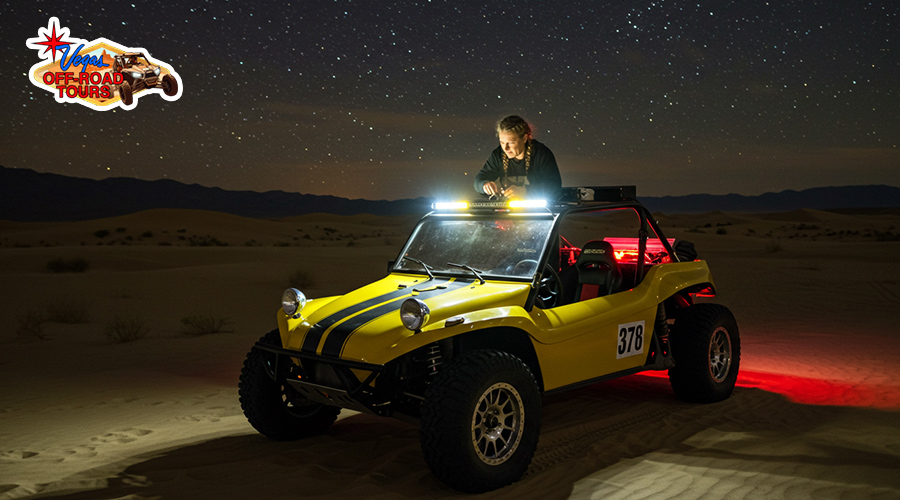
The Sky Above: Stars Like You’ve Never Seen Them
Away from city lights, the night sky over the Mojave Desert is breathtaking. On a clear night, the stars are bright enough to light up the horizon. This is one of the biggest perks of night off-roading in the Mojave Desert, you can pause your engine, step outside, and just look up.
Stargazing Tips
- New Moon Nights: The darker the sky, the better the stars.
- Avoid Light Pollution: Even small towns can dim the sky, drive deep into the desert for the best view.
- Bring Binoculars or a Stargazing App: It helps identify constellations and planets.
Some riders plan their trips around meteor showers or lunar eclipses. There’s nothing quite like watching falling stars from the bed of your truck or while sitting on a boulder in complete silence.
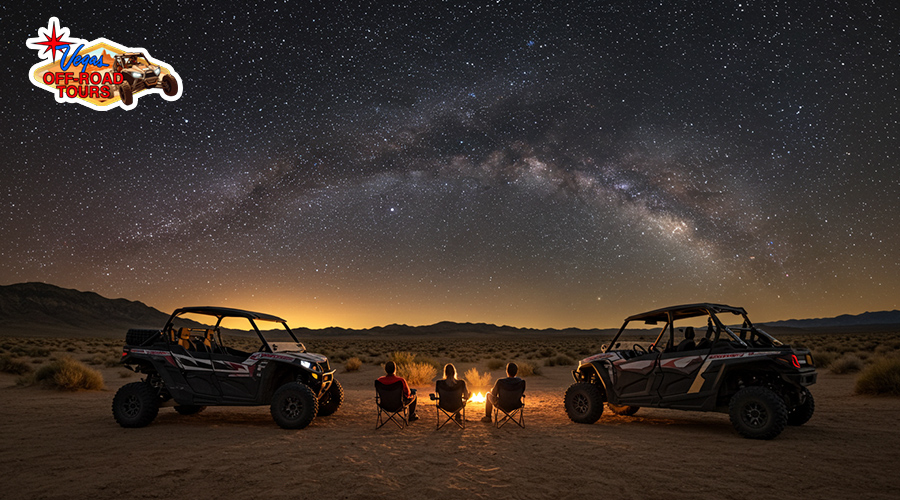
Dangers of Driving in the Dark
Night riding brings beauty, but also real risks. Reduced visibility and cooler temps can catch you off guard. Being prepared for offroading adventures can make the difference between a memorable night and a dangerous one.
Watch for These Hazards:
- Unseen Obstacles: Rocks, drop-offs, and washouts are harder to spot at night, even with good lighting.
- Wildlife Collisions: Animals often freeze in the lights, making it easier to hit them accidentally.
- Navigation Errors: It’s easy to miss trail markers or get turned around in unfamiliar terrain.
- Mechanical Failures: A breakdown in daylight is one thing. At night, it’s colder, slower, and harder to deal with.
Always share your exact route and expected return time with a trusted friend, carry at least two independent ways to call for help, a dependable GPS unit plus a fully-charged phone with a power bank, and, if you can, a satellite communicator or personal locator beacon (PLB). These devices let rescuers pinpoint you even when cell coverage disappears.
Pack for self-reliance: a minimum of 3 – 4 litres (1 gal) of water per person, plus calorie-dense food and quick protein such as trail mix, jerky, or energy bars, a flashlight with spare batteries, and a versatile toolkit or multi-tool. Dress in layers that handle both extremes (breathable, sun-protective fabrics) for daytime heat, and an insulating mid-layer (windproof shell, and beanie or gloves) for cool nights. Round it out with an emergency blanket, compact first-aid kit, and waterproof matches. Over-preparing may add a pound or two to your pack, but it’s the best trade-off for coming home safe.
Tips for First-Time Night Riders
If you’re planning your first night off-roading in the Mojave Desert, keep these simple tips in mind:
- Start with a trail you already know – Don’t learn a new route in the dark.
- WHETHER IT IS DAY OR NIGHT NEVER OFF ROAD ALONE – Go with a group or buddy.
- Check the weather and moon phase – Conditions change fast in the desert.
- Keep speed in check – You can’t dodge what you can’t see.
- Pack layers – It can drop 20–30 degrees once the sun sets.
Night off-roading is less about speed and more about awareness. Move slower, look farther ahead, and don’t rush the experience.
Final Thoughts
Night off-roading in the Mojave Desert turns a normal trail into something unforgettable. Between the cooler air, active wildlife, and jaw-dropping stars, it’s like entering a completely different world. But with that beauty comes responsibility. The desert at night demands your full attention and respect, so exploring Mojave Desert without destroying it is important.
If you’re ready for silence, stars, and wide-open space under the moon, the southern Mojave is waiting. Just make sure you come prepared, drive smart, and enjoy every second of the ride.
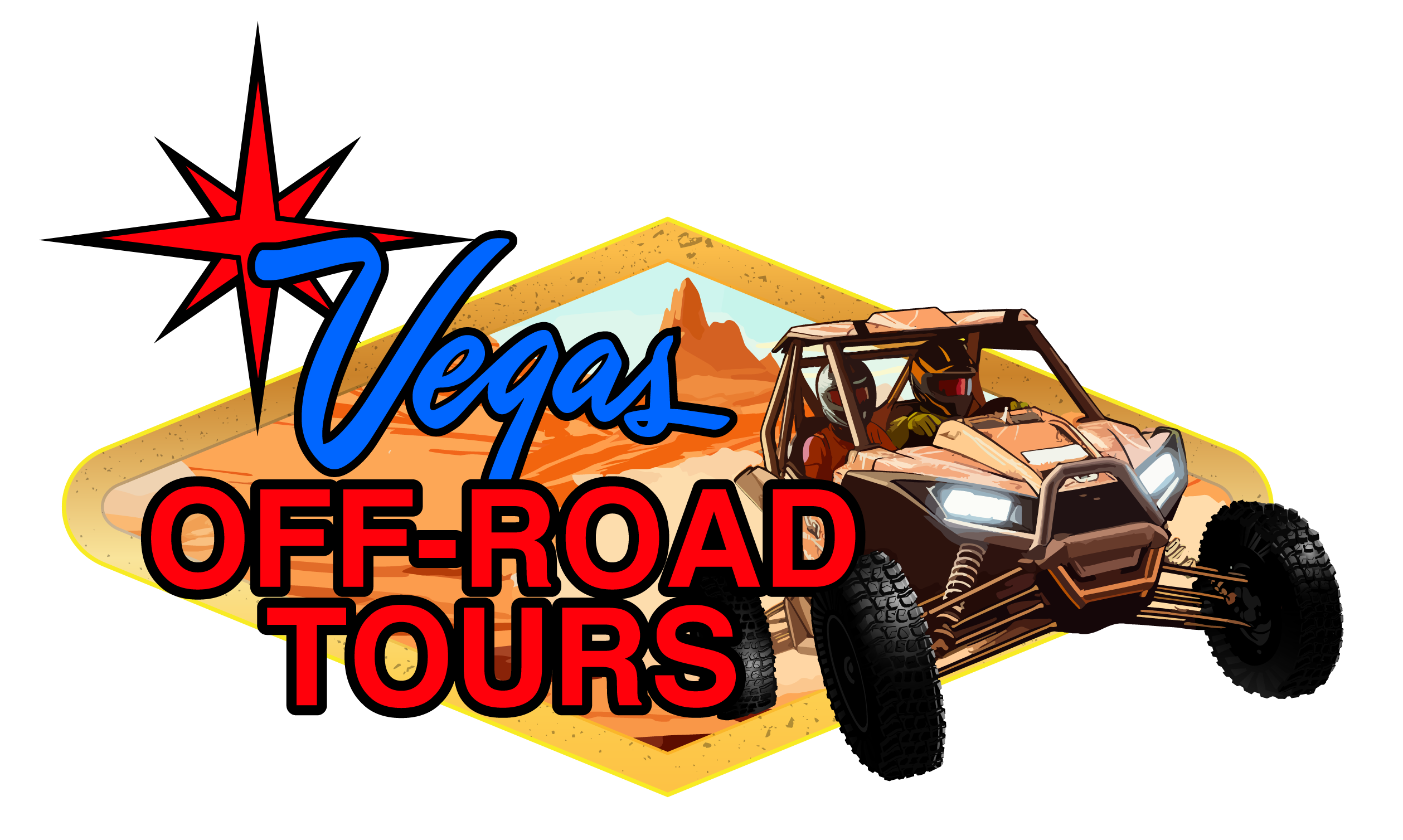
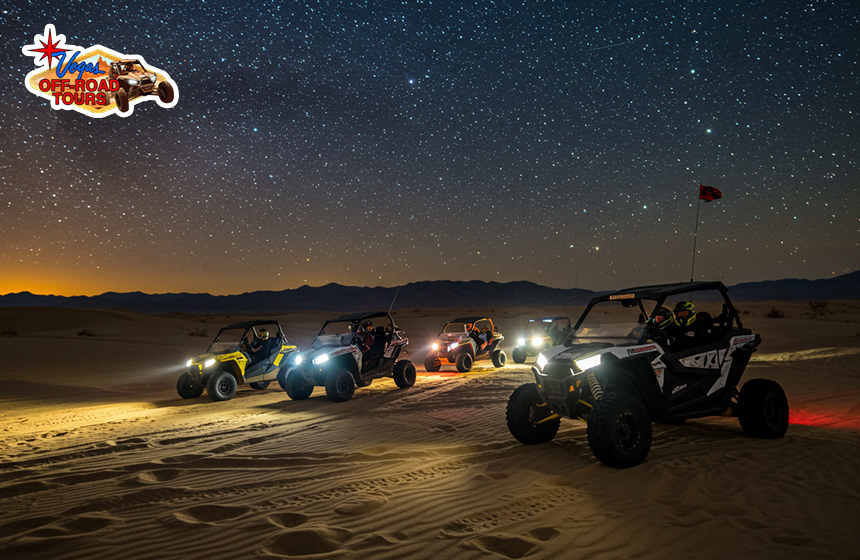

One Comment